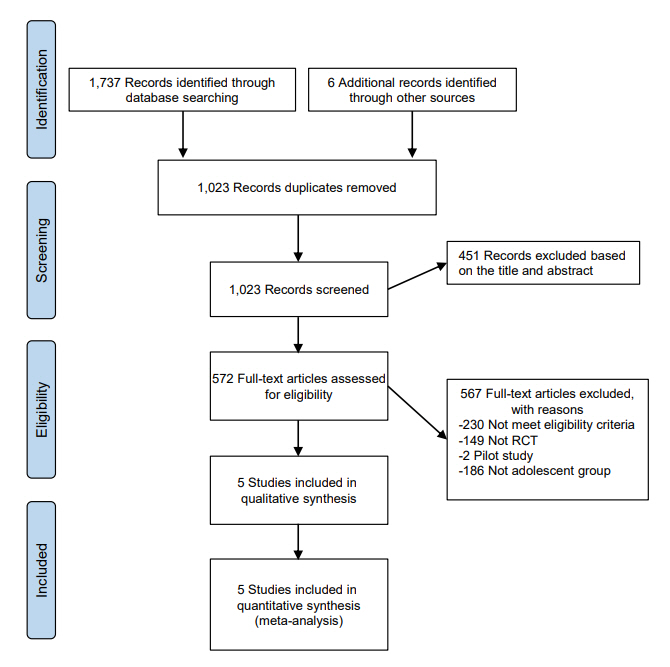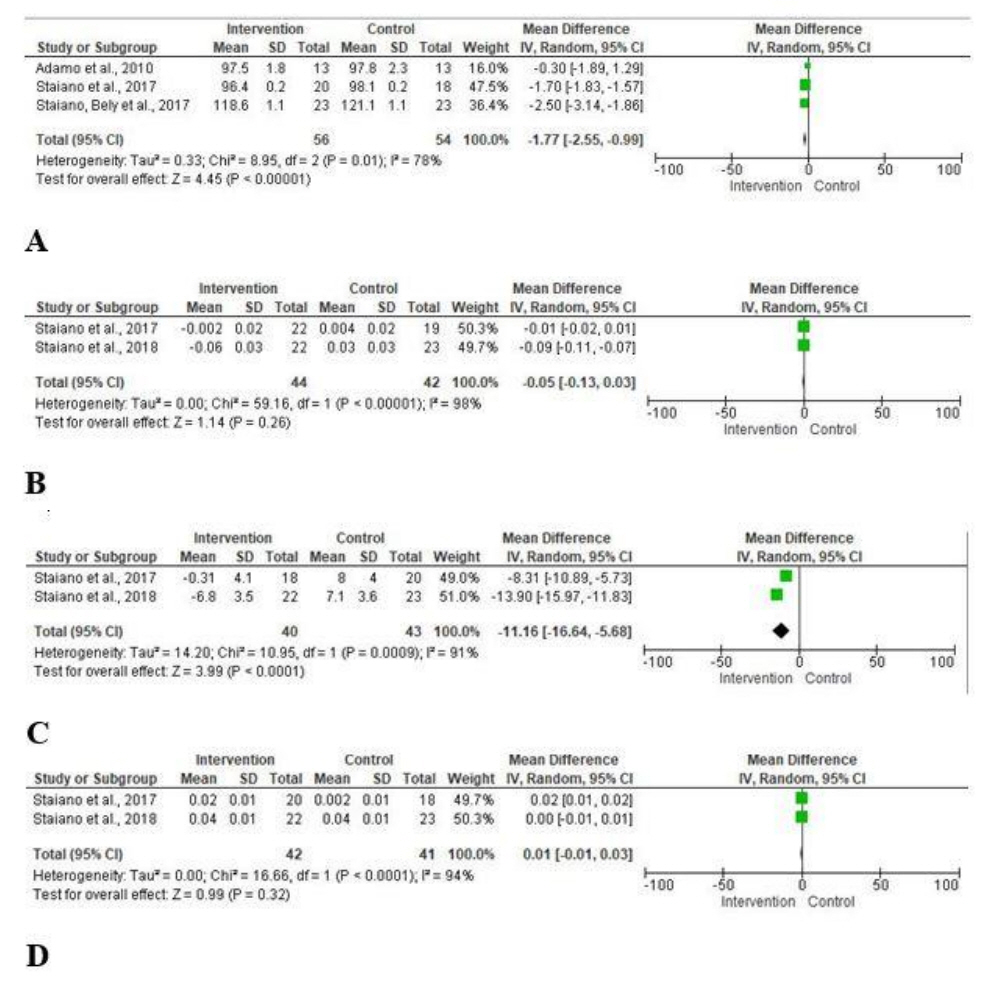Ann Pediatr Endocrinol Metab.
2022 Jun;27(2):98-104. 10.6065/apem.2244036.018.
Effectiveness of active video games in overweight and obese adolescents: a systematic review and meta-analysis of randomized controlled trials
- Affiliations
-
- 1Department of Pediatric Nursing, Nursing Department, Bandırma Onyedi Eylül University, Balıkesir/Bandırma, Turkey
- 2Department of Pediatric Nursing, Istanbul University-Cerrahpasa, Istanbul, Turkey
- KMID: 2531273
- DOI: http://doi.org/10.6065/apem.2244036.018
Abstract
- Purpose
The purpose of this review was to assess the effect of active video games among overweight and obese adolescents.
Methods
A systematic review and meta-analysis were conducted using records from the English-language electronic databases MEDLINE, the Web of Science, and PubMed. These databases were searched from January 2010 to December 2020 using the keywords (adolescent*) AND (overweight OR obese *) AND (active video games OR exergaming * OR video game*).
Results
Five articles met the inclusion criteria. Four studies were conducted in the United States of America and 1 study was conducted in Canada. In addition, all included articles had a randomized controlled trial study design. It was determined that the sample size of the studies was 30–46 participants and there were a total of 195 overweight and obese adolescents across the included studies. Active video gaming was negatively associated with changes in body mass index percentile (mean difference [MD], -1.77; 95% confidence interval [CI], -2.55 to -0.99; p<0.001) and total cholesterol (MD, -11.16; 95% CI, -16.64 to -5.68; p<0.001).
Conclusion
Playing active video games can reduce both the body mass index percentile and total cholesterol in overweight and obese adolescents. Active video games can provide a different method for combating childhood obesity. High-quality randomized controlled trials are recommended to assess the impact of game-based interventions.
Keyword
Figure
Reference
-
References
1. Williams SE, Greene JL. Childhood overweight and obesity: affecting factors, education and intervention. J Child Obes. 2018; 3:9.2. World Health Organization. Obesity and overweight [Internet]. Geneva (Switzerland): World Health Organization;2020. [cited 2020 Dec 12]. Available from: https://www.who.int/news-room/fact-sheets/detail/obesity-and-overweight.3. Bauman A, Craig CL. The place of physical activity in the WHO global strategy on diet and physical activity. Int J Behav Nutr Phys Act. 2005; 2:10.4. Maddison R, Jull A, Marsh S, Direito A, Mhurchu CN. Active videogames and weight management: is there a future? Games Health J. 2013; 2:179–82.5. Zhang T, Moore W, Gu X, Lun Chu T, Gao Z. Promoting children’s physical activity in physical education: the role of active video gaming. J Teach Res Media Kinesiol. 2016; 1:1–13.6. Biddiss E, Irwin J. Active video games to promote physical activity in children and youth: a systematic review. Arch Pediatr Adolesc Med. 2010; 164:664–72.7. Adamo KB, Rutherford JA, Goldfield GS. Effects of interactive video game cycling on overweight and obese adolescent health. Appl Physiol Nutr Metab. 2010; 35:805–15.8. Wagener TL, Fedele DA, Mignogna MR, Hester CN, Gillaspy SR. Psychological effects of dance-based group exergaming in obese adolescents. Pediatr Obes. 2012; 7:e68–74.9. Staiano AE, Beyl RA, Hsia DS, Katzmarzyk PT, Newton RL Jr. Twelve weeks of dance exergaming in overweight and obese adolescent girls: transfer effects on physical activity, screen time, and self-efficacy. J Sport Health Sci. 2017; 6:4–10.10. Staiano AE, Beyl RA, Guan W, Hendrick CA, Hsia DS, Newton RL. Home-based exergaming among children with overweight and obesity: a randomized clinical trial. Pediatr Obes. 2018; 13:724–33.11. Staiano AE, Marker AM, Beyl RA, Hsia DS, Katzmarzyk PT, Newton RL. A randomized controlled trial of dance exergaming for exercise training in overweight and obese adolescent girls. Pediatr Obes. 2017; 12:120–8.12. Santos IKD, Medeiros RCDSCD, Medeiros JAD, Almeida-Neto PFD, Sena DCSD, Cobucci RN, et al. Active video games for improving mental health and physical fitness— An alternative for children and adolescents during social isolation: an overview. Int J Environ Res Public Health. 2021; 18:1641.13. Hernández-Jiménez C, Sarabia R, Paz-Zulueta M, Paras-Bravo P, Pellico A, Ruiz Azcona L, et al. Impact of active video games on body mass index in children and adolescents: systematic review and meta-analysis evaluating the quality of primary studies. Int J Environ Res Public Health. 2019; 1613:2424.14. Higgins J, Thomas J, Chandler J, Cumpston M, Li T, Page M, et al. Cochrane Handbook for Systematic Reviews of Interventions version 6.1 (updated September 2020) [Internet]. Cochrane;2020. [cited 2020 Dec 26]. Available from: www.training.cochrane.org/handbook.15. Lamboglia CM, da Silva VT, de Vasconcelos Filho JE, Pinheiro MH, Munguba MC, Silva Júnior FV, et al. Exergaming as a strategic tool in the fight against childhood obesity: a systematic review. J Obes. 2013; 2013:438364.16. Zeng N, Gao Z. Exergaming and obesity in youth: current perspectives. Int J Gen Med. 2016; 9:275–84.17. Gao Z, Chen S. Are field-based exergames useful in preventing childhood obesity? A systematic review. Obes Rev. 2014; 15:676–91.18. Anderson LN, Carsley S, Lebovic G, Borkhoff CM, Maguire JL, Parkin PC, et al. Misclassification of child body mass index from cut-points defined by rounded percentiles instead of Z-scores. BMC Res Notes. 2017; 10:639.19. Vanderwall C, Eickhoff J, Randall Clark R, Carrel AL. BMI z-score in obese children is a poor predictor of adiposity changes over time. BMC Pediatr. 2018; 18:187.
- Full Text Links
- Actions
-
Cited
- CITED
-
- Close
- Share
- Similar articles
-
- Effectiveness of Non-pharmacological Interventions for Adolescents With Type 1 Diabetes in the Last Five Years: A Systematic Review and Meta-analysis
- Introduction to systematic review and meta-analysis
- Website and Mobile Application-Based Interventions for Adolescents and Young Adults with Depression: A Systematic Review and Meta-Analysis
- Effect of intracanal cryotherapy on postendodontic pain: a systematic review and meta-analysis of randomized controlled trials
- Effect of Sodium-Glucose Cotransporter 2 Inhibitors on Weight Reduction in Overweight and Obese Populations without Diabetes: A Systematic Review and a Meta-Analysis




